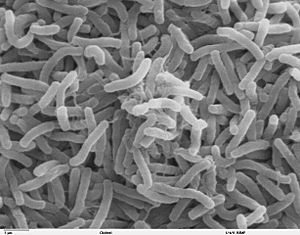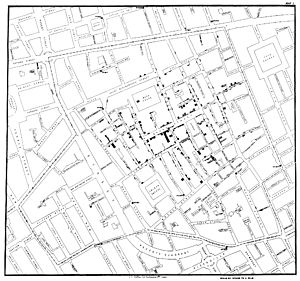Germ theory of disease facts for kids
The Germ theory of disease is a big idea in biology. It says that tiny living things, called germs or microbes, are what cause some diseases. These diseases are known as infectious diseases. When these tiny organisms get into a body, they cause a reaction, and that reaction is what we call a disease.

For a long time, people didn't know that germs caused diseases, even after the microscope was invented. Many believed that "bad air" from smelly places like trash dumps or rotting meat made people sick. They thought covering their mouth and nose would help, and doctors even used garlic or perfumes to fight this "bad air." But people still got sick, proving this idea was wrong. Polluted air itself doesn't cause diseases.
One old idea that made it hard to understand diseases was called Spontaneous generation. This was the belief that living things could just appear from non-living matter, like flies growing from rotting meat. In the 1600s, Francesco Redi showed this wasn't true. He did an experiment with meat in jars. When he sealed the meat, no maggots appeared. When he covered it with gauze, maggots appeared on the gauze but not on the meat. Only when the meat was left open did maggots appear on it. This proved that flies lay eggs that become maggots, not that meat magically turns into maggots. Later scientists used similar thinking to show that diseases don't just appear from the air; they are spread by infection.
Contents
Discovering Tiny Life
In the 1700s, Antonie van Leeuwenhoek was the first to see microscopic organisms using his own microscope. He is often called the first microbiologist. He saw some of the tiny things that cause diseases, but he didn't know what they were doing. Around 1700, Nicolas Andry suggested that some of these tiny organisms might cause diseases like smallpox. More than 100 years later, Agostino Bassi figured out what caused a disease in silkworms.
Handwashing and Cleanliness
In 1847, a doctor named Ignaz Semmelweis made an important discovery. He noticed that if doctors washed their hands after touching dead people, fewer patients got sick. This was a big step towards understanding sanitation and how important handwashing is. Around this time, some doctors started using chemicals to clean wounds and their tools between patients.
One famous story from the 1800s involves John Snow and a cholera outbreak in London. Cholera is a disease spread when human waste gets into drinking water. Snow found that many sick people in Soho, London, were getting their water from the same public pump. He solved the epidemic by having the pump's handle removed. People had to get water from other, cleaner places, and the outbreak quickly ended. This showed that diseases could be spread through contaminated water, not just "bad air."
Pasteur's Breakthroughs
Louis Pasteur proved that the germ theory was correct. In 1862, he invented a way to heat liquids to a high temperature to stop them from spoiling. This process is called pasteurization, named after him. Pasteurization is still used today to kill tiny organisms in liquids like milk, wine, and beer, making them last much longer.
Pasteur also did a famous experiment with fermentation. He put a special liquid called a broth into a jar with a very long, winding tube. Air could get in, but dust and tiny particles could not. The broth stayed clear and did not ferment. Then, he put the same broth into another jar where air and dust could easily get in. This time, the broth fermented. This showed that something very small floating in the air, not just the air itself, caused fermentation. We now know that tiny things called yeast cause fermentation.
Modern Germ Theory
In the late 1800s, Robert Koch and Joseph Lister further helped establish the germ theory of disease as a key part of science and medicine. Koch developed "postulates," which are rules that helped medical researchers figure out what causes specific diseases. Lister's ideas helped make sanitation a main way to fight diseases. Koch's rules and Lister's discoveries about cleanliness are still very important today.
We now know that many tiny things can cause diseases and infections. These include fungus, bacteria, viruses, prions, yeast, and protists.
Images for kids
See also
 In Spanish: Teoría microbiana de la enfermedad para niños
In Spanish: Teoría microbiana de la enfermedad para niños



